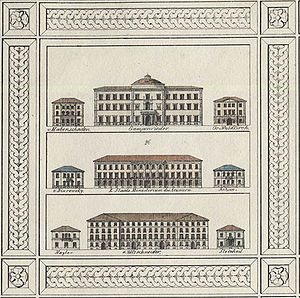
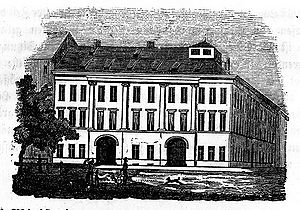
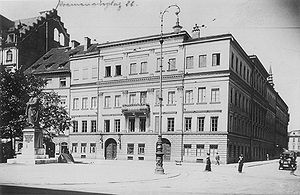
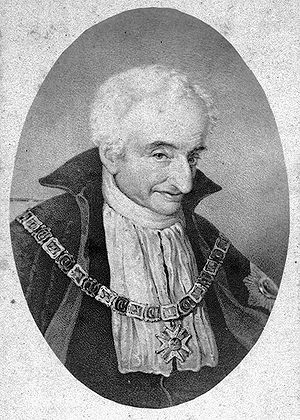
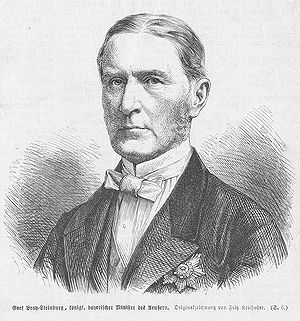
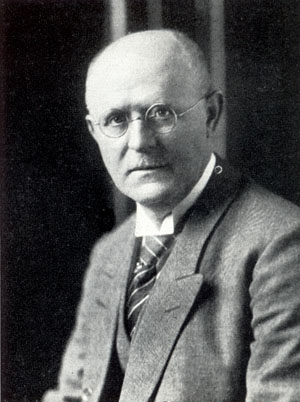
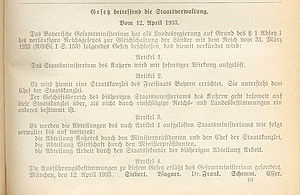
The office of Foreign Minister was at the centre of Bavarian politics in the 19th and early 20th centuries. It was usually held in combination with a leading position among the Bavarian ministers, such as Chair of the Council of Ministers (definitively since 1890) or later the office of Minister President. Nevertheless, the Ministry of Foreign Affairs has not yet been adequately researched in terms of the history of its authorities, meaning that the normative functional profiles have been sufficiently explored, but the history of its actions and impact as well as its personnel structures have not. In addition to genuine foreign policy, the Ministry of Foreign Affair's remit also included competencies in internal administration (economics, transport, social affairs), at times to a considerable extent, as well as tasks that resulted from the leading position of the Foreign Minister and which anticipated the State Chancellery as the authority succeeding the ministry after 1933.
Beginnings in the 18th century
In contrast to the other ministries, the Bavarian Ministry of Foreign Affairs – in the sense of a central hub for foreign policy – dates back to the time before the Montgelas administrative reform of 1799. Since 1762 there had been an initially relatively autonomous "Department of Foreign Affairs", responsible above all for Bavaria's relations with states outside the Holy Roman Empire. Especially after Elector Charles Theodore (1724-1799, ruled in Bavaria 1777-1799) took office, however, this institution was integrated more heavily into the Privy Conference.
Formation during the Montgelas period 1799-1817
When elector Max IV Joseph (1756-1825, ruled 1799-1825; King Maximilian I since 1806) and Maximilian Joseph of Montgelas (1759-1838) reorganized the central governmental offices of Palatinate Bavaria in 1799, placing emphasis on the departmental principle with specialised ministries, the "Department of Foreign Business" (from 1801 on "Department of Foreign Affairs"), which was always managed by Montgelas himself, was given a prominent position above the Finance and Justice Departments and the "Department of Ecclesiastical Affairs". Foreign policy was the exclusive responsibility of the prince. Moreover, in view of Bavaria's involvement in the changing alliances during the Napoleonic Wars and considering the looming threat of occupation by Austria, foreign policy was of particular importance in the period leading up to the Congress of Vienna (1814/15).
However, even during the Montgelas period (which lasted until the fall of the minister in 1817), the work of the Ministry of Foreign Affairs extended beyond this expected core area and – in the first decade of the 19th century – also included areas of internal constitutional law related to the electoral or royal household, such as matters of sovereignty and fiefdom, the granting of the indigenate and the bestowal of nobility, negotiations with the estates, the family fideicommissum and private princely law, as well as the supervision of the central archives and the postal system. From 1808 to 1825, the Ministry of Foreign Affairs included the Imperial Heraldry Office, which, in addition to ceremonial tasks (including the customary and important bestowals of orders in the 19th century), had an important role in integrating nobility into the new Bavarian state by managing the nobility register.
The Ministry of Foreign Affairs in the Kingdom 1817-1918
Even after the end of the Montgelas era, the ministry "of the Royal House and the Foreign Affairs" (designation since 1817) continued to be responsible for Bavaria's foreign relations: correspondence and negotiations with foreign countries and the German Confederation and, since 1871, the German Reich, diplomatic relations as well as consular exchange – at times in association with the Ministry of Commerce. During the course of the 19th century, fields of work from the area of the incipient mass emigration, in particular to North America, gained importance. While the Ministry of Trade and Commerce temporarily broke the Ministry of Foreign Affairs' monopoly on foreign relations with their functions in the field of foreign trade, in 1904 the Ministry of Foreign Affairs was given far-reaching authority in the field of Bavaria’s domestic industry.
The numerous reorganisations of the ministries and their areas of responsibility in the course of the 19th and early 20th centuries mainly affected the fields of work pertaining to domestic policy at what had now become the Ministry of State of the Royal House and of Foreign Affairs. For example, postal services were moved to the Ministry of Finance in 1825, then back to the Ministry of Foreign Affairs in 1832, to the Ministry of the Interior in 1847, to the new Ministry of Trade in 1848, after its abolition in 1871 back to the Ministry of Foreign Affairs – together with the transport sector – and to the new Ministry of Transport in 1903.
The Foreign Minister held the office of chairman of the Council of Ministers created in 1849 almost continuously (exception: 1880-1890); this dual mandate was finally established in 1890.
In 1817, the ministry moved from the ministerial building in Munich‘s former Theatinerkloster (Theatinerstraße today) to the Palais Montgelas on Promenadeplatz, where it remained until its dissolution in 1933.
The Ministry of Foreign Affairs during the Weimar Republic (1918-1933)
During the Weimar Republic, the profile of what was now called the "State Ministry of Foreign Affairs" was initially reduced greatly by the removal of the royal house as a prominent area of responsibility and the transfer of almost all domestic and economic policy responsibilities to other ministries (1918/19). In addition, the Unitarian Weimar state limited the states' foreign policy framework of action to a greater extent than the Empire had previously. The dual mandate of Foreign Minister and Minister President therefore defined the ministry's work even more now, with the ministry increasingly taking on key political tasks from the Minister President's area of expertise. However, the plan to transform the ministry into a state chancellery formally as well initially remained unimplemented for fear of the symbolic significance of this step: abandonment of sovereignty.
The Ministry of Foreign Affairs experienced a brief renaissance in the late 1920s. In 1928, after years of debate about a reform, the Ministry of Trade – set up in 1919 – was reintegrated into the Ministry of Foreign Affairs. The renewed and apparently permanent allocation of political responsibilities in internal affairs culminated in the Ordinance on the State Ministries from 11 February 1932: The "State Ministry of Foreign Affairs, Economic Affairs and Labour" now also acquired the department of labour from the dissolved Ministry of Agriculture and Labour. Its area of responsibility included industry, trade and craft, commerce and transport as well as social administration.
Dissolution of the Ministry of Foreign Affairs 1933
In the course of the reorganisation of the executive in Bavaria by the National Socialists, the Bavarian Ministry of Foreign Affairs was dissolved by a law passed by the Bavarian "Gesamtministerium" on 12 April 1933. The management tasks were essentially transferred to the now established State Chancellery, the areas of economic affairs and labour were transferred to the new Ministry of Economic Affairs.
| Foreign Minister | Biographical data | Ministerial term | Remarks |
|---|---|---|---|
| Baron Maximilian (since 1809 Count) of Montgelas | 1759-1838 | 21 February 1799 - 2 February 1817 | |
| Count Aloys von Rechberg and Rothenlöwen | 1766-1849 | 2 February 1817 - 26 October 1825 | |
| Count Friedrich von Thürheim | 1763-1832 | 1 January 1826 - 29 August 1828 | |
| Count Joseph von Armansperg | 1787-1853 | 30 August 1828 - 31 December 1831 | |
| Baron August von Gise | 1783-1860 | 2 January 1832 - 1 June 1846 | |
| Count Otto von Bray-Steinburg | 1807-1899 | 1 June 1846 - 4 April 1847 | |
| Georg v. Maurer | 1790-1872 | 17 September 1847 - 29 November 1847 | as administrator |
| Prince Ludwig zu Oettingen-Wallerstein | 1791-1870 | 1 December 1847 - 11 March 1848 | as administrator |
| Count Klemens August von Waldkirch | 1806-1858 | 14 March 1848 - 29 April 1848 | as administrator |
| Count Otto von Bray-Steinburg | 1807-1899 | 29 April 1848 - 18 April 1849 | |
| Ludwig von der Pfordten | 1811-1880 | 18 April 1849 - 1 May 1859 | Presidency of the Council of Ministers |
| Baron Karl von Schrenck von Notzing | 1806-1884 | 1 May 1859 - 4 October 1864 | Presidency of the Council of Ministers |
| Max v. Neumayr | 1808-1881 | 4 October 1864 - 4 December 1864 | as administrator |
| Baron Ludwig von der Pfordten | 1811-1880 | 4 December 1864 – 29 December 1866 | Presidency of the Council of Ministers |
| Prince Chlodwig zu Hohenlohe-Schillingsfürst | 1819-1901 | 31 December 1866 - 7 March 1870 | Presidency of the Council of Ministers |
| Count Otto von Bray-Steinburg | 1807-1899 | 8 March 1870 - 25 July 1871 | Presidency of the Council of Ministers |
| Count Friedrich von Hegnenberg-Dux | 1810-1872 | 21 August 1871 - 2 June 1872 | Presidency of the Council of Ministers |
| Adolf v. Pfretzschner | 1820-1901 | 1 October 1872 – 4 March 1880 | Presidency of the Council of Ministers |
| Count Krafft von Crailsheim | 1841-1926 | 4 March 1880 - 1 March 1903 | Presidency of the Council of Ministers since 1890 |
| Count Clemens von Podewils-Dürniz | 1850-1922 | 1 March 1903 - 9 February 1912 | Presidency of the Council of Ministers |
| Count Georg von Hertling | 1843-1919 | 9 February 1912 - 10 November 1917 | Presidency of the Council of Ministers |
| Otto v. Dandl | 1868-1942 | 11 November 1917 - 8 November 1918 | Presidency of the Council of Ministers |
| Kurt Eisner | 1867-1919 | 8 November 1918 - 21 February 1919 | Minister President, USPD |
| Johannes Hoffmann | 1867-1930 | 18 March 1919 – 13 March 1920 | Minister President, MSDP |
| Gustav v. Kahr | 1862-1934 | 16 March 1920 - 11 September 1921 | Minister President, BVP |
| Count Hugo von und zu Lerchenfeld auf Köfering und Schönburg | 1871-1944 | 21 September 1921 - 2 November 1922 | Minister President, BVP |
| Eugen Ritter v. Knilling | 1865-1927 | 8 November 1922 - 5 May 1924 | Minister President, BVP |
| Heinrich Held | 1868-1938 | 28 June 1924 - 15 March 1933 | Minister President, BVP |
| Franz Ritter v. Epp | 1868-1947 | 16 March 1933 - 12 April 1933 | Reich Governor and acting Minister President, NSDAP |
Documents
- Verordnung über die Errichtung von fünf Staatsministerien vom 2. Februar 1817. (aus: Königlich-Bayerisches Regierungsblatt 1817, 49-56)
- Formationsverordnung für die Staatsministerien vom 15. April 1817. (aus: Königlich-Bayerisches Regierungsblatt 1817, 329-368)
References
- Caroline Gigl, Die Zentralbehörden Kurfürst Karl Theodors in München 1778-1799 (Schriftenreihe zur bayerischen Landesgeschichte 121), München 1999.
- Isabella Kratzer, Der Bayerische Ministerpräsident. Bedeutungswandel des Amtes im Spiegel der Geschäftsordnungen der Staatsregierung (1918-2001) (Forschungen zur Landes- und Regionalgeschichte 10), Sankt Ottilien 2003.
- Horst Raffael, Ausbau und Entwicklung der Ministerialverfassung Bayerns unter Maximilian von Montgelas 1799-1808. Eine verfassungsgeschichtliche Studie, Diss. masch. München 1952.
- Walter Schärl, Die Zusammensetzung der bayerischen Beamtenschaft von 1806 bis 1918 (Münchener Historische Studien 1), Kallmünz 1955, 15-17, 234-243.
- Michael Unger, Das bayerische Staatsministerium für Handel, Industrie und Gewerbe: Organisation, Geschäftsbereiche, archivalische Überlieferung, in: Archivalische Zeitschrift 87 (2005), 39-79.
- Wilhelm Volkert, Handbuch der bayerischen Ämter, Gemeinden und Gerichte. 1799-1980, München 1983, 23-26.
- Wilhelm Volkert, Die Staats- und Kommunalverwaltung, in: Max Spindler (Begr.)/Alois Schmid (Hg.), Handbuch der bayerischen Geschichte. Vierter Band: Das neue Bayern. Von 1800 bis zur Gegenwart. Zweiter Teilband: Die innere und kulturelle Entwicklung, München 2. Auflage 2007, 72-153, hier 79-80.
Sources
- Maria Schimke (Bearb.), Regierungsakten des Kurfürstentums und Königreichs Bayern (Quellen zu den Reformen in den Rheinbundstaaten 4), München 1996.
Further Research
External Links
Related Articles
- Auswärtige Gesandtschaften in München
- Bayerische Gesandtschaften (19./20. Jahrhundert)
- Staatsministerium für Wirtschaft, Infrastruktur, Verkehr und Technologie
- Vertretung des Freistaates Bayern bei der Europäischen Union
- Wittelsbacher (19./20. Jahrhundert)
- Zentralstelle für Industrie, Handel und Gewerbe, 1907-1914/18
Außenministerium, Staatsministerium des Äußern und des Königlichen Hauses, Staatsministerium des Äußern, für Wirtschaft und Arbeit
Cite
Martin Ott, State Ministry of Foreign Affairs, first published 10 April 2007, English version published 22 March 2024; in: Historisches Lexikon Bayerns, URL: <http://www.historisches-lexikon-bayerns.de/Lexikon/EN:State_Ministry_of_Foreign_Affairs> (20.12.2025)
